|
Monday, October 20, 2008
Progress Notes
Saturday, October 25 at 11 a.m. the annual Bagnell Reunion once again is being celebrated at Camp Bagnell Fish & Steakhouse at Old Bagnell (see advertising flyer photo 01 and photo 01a of the restaurant).

01 Old Bagnell Reunion
Click on image for larger view
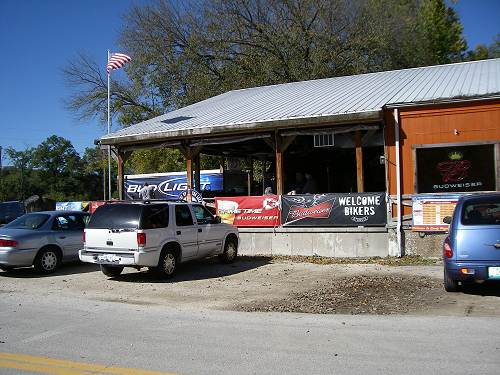
01a Camp Bagnell Fish and Steak House
This is an event where all who are curious or are interested in the history of Old Bagnell can come and reminisce. Regular attendees always include current and former residents and friends of the community as well as a good number of locals who enjoy hearing the old stories and to dine on excellent food provided by hosts Jerome, Pat, Caitlin and Colton Schulte. Since retirement and moving back to the area a few years ago I always attend, especially since my grandfather, Madison Bear, owned a general store at Old Bagnell for ten years while the Dam was being built.
So in anticipation of this annual upcoming event I thought I would devote some space this week to Old Bagnell. Not that we haven’t already featured Old Bagnell on our website which you can also read at this URL:
http://www.millercountymuseum.org/communities/bagnell.html
I certainly encourage you to read the articles on the website cited above to get a full perspective of the history of Bagnell, a very interesting and important part of our Miller County history.
But for this week, I thought I would present a copy of an article from the Miller County Autogram written some forty years ago since it gives some additional history in addition to what is already on our website. Especially interesting are the several interviews included in this particular article. I found the article as a clipping in a scrapbook filed away in our museum library. Unfortunately, the clipping was cut out in such a way that I don’t know who the author was. Maybe one of you readers know the author and can let me know.
Miller County Autogram 19 October 1967
C. A. Beeson, Chief of Police at Bagnell, rounded up 72 bums in this town in one day last week and shipped them over the Missouri Pacific. He said it became necessary to get the men out of town as there was no room for them and nearby farmers were complaining of losing the potatoes and garden…
So went life in the boom days of Bagnell…a Miller County community with a colorful history of floods, ferryboats, and fires. Bagnell was born with the extension of the Jefferson City, Lebanon and Southwestern Railroad (which later became the Missouri Pacific) into Miller County in the early 1880’s. Before that time, a church, known as Old Gilgal, was the center of attraction in that area. The church, located on the point of a hill at the mouth of the Little Gravois Creek at the Osage River, was the scene of the first annual session of the Miller County Association of Baptist Churches in September of 1845.
Preceding Bagnell was the village of Adelaide, also on the Osage River, a short distance from the Bagnell community. In 1889, Adelaide had a population of 75 and boasted a blacksmith’s shop, post office, saw and grist mill and a large store. In 1885, the Adelaide post office was moved to the new town of Bagnell, according to research by Clyde Lee Jenkins, deputy county clerk.
Mrs. R.P. (Bob) Howser, 214 S. Mill Street, Eldon, grew up in Bagnell at the turn of the century and recalls much of the community’s early history. According to stories Mrs. Howser heard many times as a child, Bagnell was named for Bill Bagnell, who started a store across the Little Gravois Creek from Bagnell, and later agreed to grade the switch bed the end of the line if the place would be named for him.
(Note: If you refer to our website about Bagnell listed above, as well as a previous Progress Notes from April 7, 2008,
you can read more about William Bagnell (photo 02) who really was an eastern tycoon involved heavily with the railroad industry.)
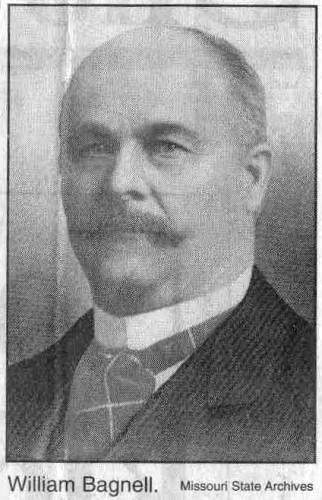
02 William Bagnell
As soon as the first trains began running on the Bagnell Branch in 1882, the line began to carry freight formerly shipped by Osage Riverboats to Osage City. (Here is photo 03 of the old Bagnell depot:)
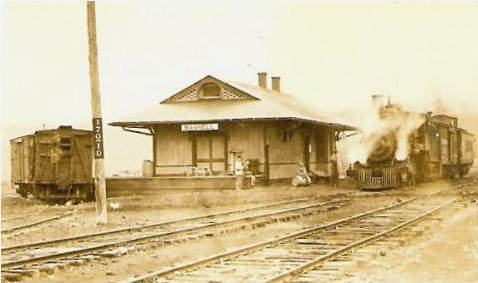
03 Bagnell Depot
“The State of Missouri,” written by Walter Williams and published in 1904, noted that “More railroad ties are loaded at Bagnell, Miller County, than at any other point in Missouri.”
At the turn of the century, white oak railroad ties were bringing 28 cents each. Virtually all farmers were engaged in manufacture of white oak ties, Williams’ book reported, which were cut from land adjacent to the Osage and Niangua Rivers, rafted to Bagnell and loaded there upon cars of the Missouri Pacific railroad (photo 04 of ties).
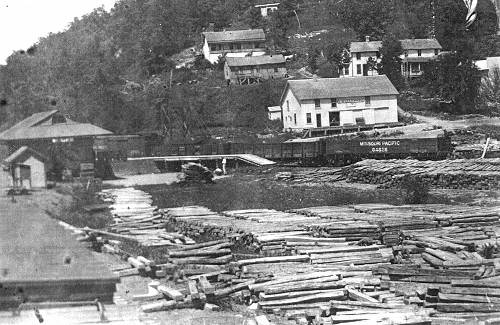
04 Bagnell Tie Yard
Mrs. Howser, a daughter of J.S. Mahan, a Bagnell minister, says that in the early 1900’s, the era of open saloons, the “rafters”virtually took over the town when they visited Bagnell and the refreshment centers. “The women and children had to stay in the house when the rafters came,” Mrs. Howser recalls.
Leaders in the tie industry in the late 1800’s were R. S. Harvey, who founded the Bank of Eldon in September of 1894, when that community had a population of 379, and J.S. Franklin. Harvey was in the tie business for 25 years in the six county area, and furnished ties for construction of the Bagnell branch railroad (photo 05 of R.S. Harvey).
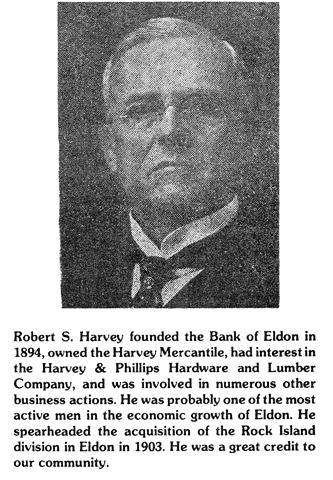
05 Robert S. Harvey
One of the many floods hitting Bagnell, and one of the worst, was during Christmas week, 1895. On December 26, 1895, the Miller County Autogram, Tuscumbia weekly newspaper, reported:
“The river is over a mile wide at Tuscumbia. R.S. Harvey and J.S. Franklin came down from Eldon last Wednesday evening to pay their taxes and left nearly a thousand dollars with collector Cotton. They were hurried home by the rising river and proceeded to Bagnell, where it is said they had nearly 100,000 ties piled up in the yard. We understand they telegraphed to Jefferson City for a train load of laborers, but were unable to get them. Their loss will undoubtedly be considerable.”
Later accounts, however, indicated that Harvey and Franklin’s loss was not too large. The men filled boxcars with railroad ties and used the cars to form a dike to prevent the stacked ties from floating into the river.
(Note: Here is photo 06 of the 1912 flood of Bagnell. I couldn’t find a photo of the 1895 flood:)
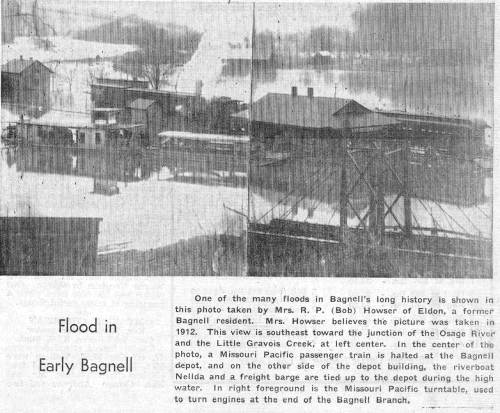
06 Flood In Early Bagnell
Click image for larger view
The Autogram, in that 1895 flood issue, also reported that “The Anchor Mill Company has 40 or 50 cords of good dry wood somewhere between Tuscumbia and the Gulf of Mexico.”
For more that 50 years, large portions of Miller and Camden counties were served by the Bagnell ferry, which provided a vital transportation link across the Osage River (photo 07 of ferry).
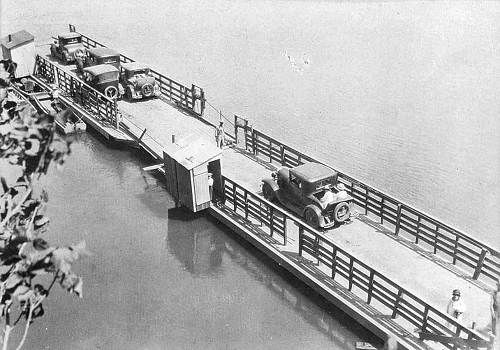
07 Bagnell Ferry
The Bagnell ferry served the area...and served it well…from the early 1880’s until the late 1930’s. Clyde Lee Jenkins, deputy county clerk, reported Miller County Court records show that the first ferry in the vicinity of present day Bagnell was authorized on December 21, 1882, at or near what was then known as the Elm church Ford on the Osage. The county court gave Samuel Umpsted authority to charge the following rates on this first ferry: Four horses or oxen and wagon, $1; two horses or oxen and wagon, 50 cents; 1 horse and buggy, 30 cents; horse or mule, and rider, 20 cents; loose horses and cattle; 10 cents per head; hogs 5 cents; sheep; 3 cents; freight, other than in wagons, 10 cents per 100 pounds.
Jenkins reports that the first license to keep a ferry across the Osage River at Tuscumbia, and the first issued after formation of Miller County, was on August 8, 1837, to Cornelius P. Davidson. The deputy county clerk said his research leads him to believe that the first ferry in the territory which later became Miller County, was at the Brockman Ford, near Tuscumbia.
Court records of February 7, 1877, show that W.S. Brockman and P.M. Carmack presented a petition from citizens of Franklin Township asking the court to grant the two men a license to keep a ferry across the Osage at Bagnell. The court ordered that the men have a five year license, by paying to the county $2 as a state tax, and that they post $1000 bond to the State of Missouri.
Other Bagnell ferry operators listed in Miller County records include W.H. Waddle, November, 1889, and R.S. Thorp, May, 1892.
In August of 1896, the county court advertised for bids for operation of the Bagnell ferry, and awarded the five year contract to John N. Brockman on December 4.
Jackson C. Stanton of Tuscumbia, former magistrate judge of Miller County, recalls driving hogs and cattle to Bagnell from the family farm near Brumley in the 1890’s and early 1900’s (photo 08 of Stanton).

08 Jackson C. Stanton
Stanton said that he began “trailing hogs” in 1890, when he was six years old, and helped his father in this work until the latter’s death in 1903. The former judge said they would drive from 150 to 300 head of hogs from the Stanton farm southwest of Brumley to the Osage at Bagnell then cross the river on the ferry and load the hogs on the Missouri Pacific railroad, where they were shipped to St. Louis.
“We would take a Springfield wagon full of ear corn ahead of the hogs and shell it out…they soon found out where it was coming from and would follow the wagon,” Stanton said. Three or four boys hired at a daily rate of 25 cents each, would follow the hogs with a stock dog, he added.
The trip from Brumley to Bagnell took two days, Stanton recalls. “By sundown of the second day, we would reach Bagnell and drive 40 to 50 head of hogs onto the ferry at a time.”
The hogs, Stanton said, were then held in hog pens at Bagnell until they were sold, loaded and shipped over the railroad. “Two cents a pound was the least we ever got.” He said.
On his first trip to Bagnell, Stanton saw something he never forgot. As they approached the ferry, the young boy looked across the river and saw a white mule plodding around an around in circles, pulling a whim…a device which pulled a small sled loaded with railroad ties from the river bank to the tie yards. Judge Stanton recalls that during most of his trips to Bagnell, Judge John N. Brockman…elected a county court judge seven times…was operator of the ferry there.
(Here is a photo of the old ferry bell, photo 08a:)
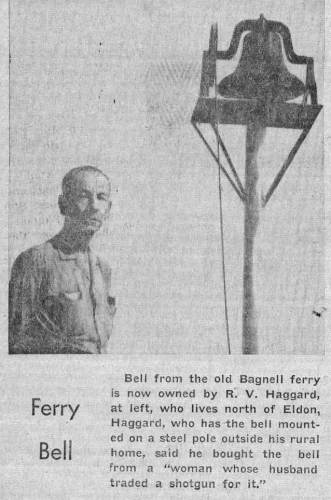
08a Ferry Bell
Click image for larger view
(Note: You can read more about Judge Jackson in the Progress Notes for November 26, 2007.
You will need to scroll half way down the page to get to the section about Judge Jackson.)
The Big Boom at Bagnell came with construction of the Bagnell Dam across the Osage River (photo 09 of dam).
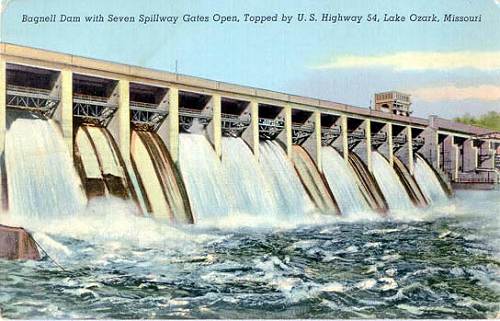
09 Bagnell Dam
Work on the Dam began in August of 1929 and that month, a four mile railroad track was built across the Little Gravois Creek from the end of the spur at Bagnell to the Dam site. A gravel road also connected the two points.
New businesses opened at Bagnell as work on the Dam got underway, and the Bagnell Branch hauled virtually all materials used in construction of the Dam.
The September 26, 1929 Eldon Advertiser reported, “The Missouri Pacific handled eight trains over the Bagnell Branch Thursday.
Gravel trains and material trains for Bagnell Dam have been making the branch a busy road.” The same issue stated “There are now 14 eating places at Bagnell since the Bagnell Dam started.” And in November of 1929, the newspaper reported a steam laundry had been established at Bagnell.
“Most of the Missouri Pacific trains carrying materials for the Dam require three large engines and are operated as doubleheaders with an extra engine about the center of the train so that the combined weight will not endanger the bridges.”…June 5, 1930 Advertiser.
The U.S. census report in early 1930 showed Bagnell’s population at 449. Eldon also enjoyed prosperous growth from construction of the Dam, with an official population of 3165. As work on the Dam continued, the need for better roads increased. In October of 1930, crews were busy working on a bridge over the Little Gravois to carry Highway 54 traffic to Bagnell Dam.
(Note: The same bridge was removed for the new Highway 54 bypass around Bagnell Dam.)
Along with its population growth , Bagnell was improving in the entertainment field, with the announcement in August of 1930 that the Orient Theatre had opened for Friday and Saturday shows. The preceding January, officials from neighboring towns were guests at a dinner sponsored by the Bagnell Chamber of Commerce which had a thriving membership and dues of $12 a year.
The labor force working on Bagnell Dam hit its peak in November of 1930 when slightly over 4000 men were working on the mammoth project. By the next month, the number of employees had dropped to 3810.
During construction of the Dam, new rooming houses were built, and were soon filled to capacity. Many workers and their families lived in tar paper shacks and tent cities flourished.
Fires plagued Bagnell almost as frequently as the floodwaters of the Osage River. On November 6, 1930, The Advertiser reported two children, ages four and two, burned to death when their home…a tent…caught fire. The family’s tent, the newspaper reported, had been soaked in oil to make it waterproof.
The river community suffered a staggering blow on March 16, 1931, less than a year after it was announced that the gates of Bagnell Dam had been closed and the Lake was beginning to form. Two men burned to death and nearly all of the original town of Bagnell was destroyed in an early morning fire.
The blaze started in a building where Harvey and Franklin had bought ties and sold general merchandise at Bagnell in the 1880’s. Destroyed were the Reed & Berry general store, four rooming houses, an electrical goods store, a confectionery rooming house, café, restaurant-rooming house, barber shop, jewelry store, post office-residence, store building-rooming house, telephone office, the Bagnell Water System office and city hall and the Oriental Hotel and Theatre. The loss was estimated at $100,000.
The Eldon Advertiser, in reporting on the fire, said Edgar Wilson of the White Hall Hotel forced open doors of 27 rooms and routed sleeping guests from the hotel as the fire began to spread.
Mrs. R.P. (Bob) Howser, who moved from Bagnell to Eldon two years before the fire, recalls that the fire was almost inevitable. “We all knew it would happen some day…there were too many paper shacks thrown up.”
Mr. and Mrs. Harry Rea, 305 North Aurora Street, Eldon, were living in Bagnell when it was hit by the fire. Rea, who was operating the Bagnell Ferry at the time, was credited with saving the J.C. Calkin Second Hand store, near the end of Ferry street, by spreading wet blankets over exposed portions of the building.
(Note: My Aunt Lena (Brown) Bear, who was married to my mother’s brother, Arthur Bear, was staying overnight at the time with the Calkins’. She told me she saw the fire through the window and rushed outside. Immediately, she and others formed a bucket brigade to help put out the fires of several buildings as best they could. However, most of the effort was too late. At the time, Aunt Lena had not yet married my Uncle Arthur; she often stayed in Bagnell overnight when she was baby sitting for various people. Her home farm was just across the river from Bagnell and it was easy for her to take the ferry back and forth.)
More fires followed the big blaze of March, 1931. The next month, six stores and a home were destroyed at Bagnell, including a grocery-poultry store, the White Way café, Red Moore’s Café, Boots garage building and Moore Drug Company. Remaining were the A.M. Pope Lumber Company, J.C. Calkin Second Hand Store and a filling station. The loss was estimated at $25,000 to $30,000.
Along Route V in Bagnell today, the remains of buildings destroyed in the 1931 fires are visible. Concrete walls of some buildings still stand, with large trees now grown up inside the building shells.
Bagnell’s boom was almost over. On Decoration Day, 1931, Highway 54 over Bagnell Dam was opened to traffic. Less and less traffic crossed the Bagnell ferry, and the population began to taper off from its peak of 1930.
Mrs. Ernest Boots, who had lived in Bagnell longer than any other resident, said that the days of the Bagnell Dam boom were not all pleasant ones in Bagnell.
“Many families sold their homes to come work on the Dam,” Mrs. Boots said. “Some found work …and some didn’t.” During construction for the Dam, she said hungry, unemployed men living in camps along the river and railroad tracks would kill chickens and steal from the garden, only a few feet from the house. “I finally gave up and sent what chickens we had left to the farm. It was all I could do to watch the children.”
The increase in Bagnell’s population during work on the Dam crowded Bagnell’s schools to the limit, Mrs. Boots recalls. Classes were held in adjacent buildings, one a frame structure, the other concrete.
(Note: Here are photo 11 and photo 12 of Bagnell schools which unfortunately are of poor quality since they were copied from the article:)
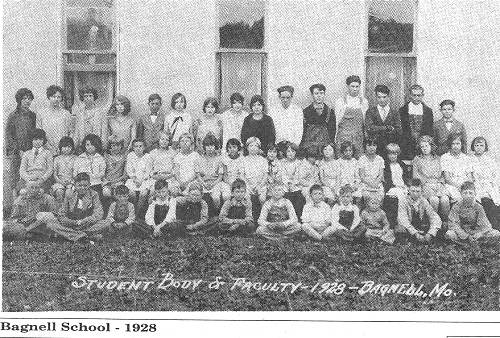
11 Bagnell School - 1928
Click image for larger view

12 Bagnell School
Click image for larger view
In 1933, the Bagnell high school was closed and shifted to the new school at Lake Ozark. The lower six grades continued in operation at Bagnell until the fall of 1939, when they too were moved to a new elementary building at Lake Ozark. Among the teachers in the old Bagnell schools were Mrs. Leland Mills and Burl Henderson, both later associated with School of the Osage at Lake Ozark.
Mrs. Boots, who first came to Bagnell in early 1913, recalls many of the community’s exciting events…including the day a freight train hit the R.P. (Bob) Howser home.
For several years, Mrs. Boots’ late husband and his brother, Oscar Boots, operated a freight boat on the Osage. Later, Oscar Boots ran the Boots Hotel, formerly the Brockman Hotel, established in Bagnell at the turn of the century. In 1915, the hotel was one of three operating in Bagnell (photo 13 of Boots Hotel).

13 Boots Hotel
The disastrous fire of 1931 was followed by another disaster…the flood of 1943. The Osage, reaching the highest stage on record, sent water into the second story of the house Mrs.Boots lived…the house in which she had lived 42 years. She recalls that the river went up 16 feet from the evening meal to noon the next day. The flood, which followed an 11 inch rain, left only two houses above water at Bagnell, the homes of Rena Cotton and Leona Huddleson.
As the river hit a record stage of 48.5 feet (at Tuscumbia) soldiers from Fort Leonard Wood sandbagged Bagnell Dam as water neared the top of the structure. The floodwaters closed Highway 54 from the Gier Cotton bait shop to above the Homer Quinn Grocery store.
Mrs. Joe Woolley, Bagnell correspondent for The Advertiser reported in the June 10, 1943 edition:
“The piano and some of the old seats of the Bagnell Baptist Church were ruined by the high water. Most everybody’s furniture was completely ruined by the flood in Bagnell. Carl Adam’s house floated into Ernest Boot’s garden and his garage and car went down the river.”
Two weeks later, Mrs. Woolley reported that church at Bagnell was held on Saturday night, for the first time for two months on account of high water.
(Note: Here is photo 14 of a Bagnell flood in 1941. I couldn't find one for 1943.)
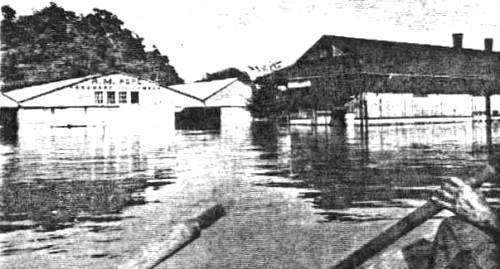
14 Depot and Pope's Lumber Yard - 1941
As the floodwaters left Bagnell, so did many of her residents. The Missouri Pacific’s line was soon shortened to end at Highway 54, and the depot was moved to near Quinn’s store. The Bagnell Baptist Church congregation decided to build a new church on the highway.
(Note: Here is photo 15 and photo 16 of the Old Bagnell Baptist Church.)
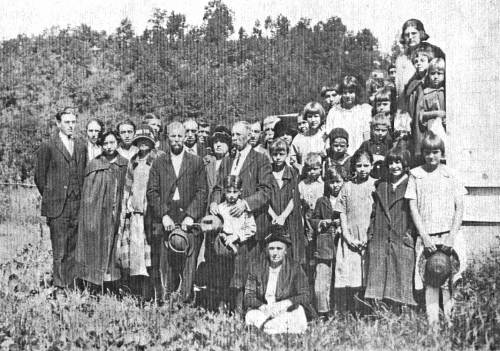
15 Oliver Brockman (Left) - Sunday School at Bagnell Church - 1924
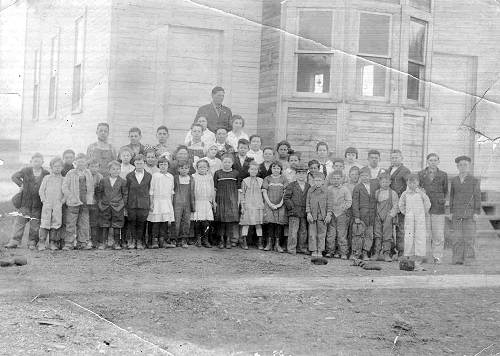
16 Old Bagnell Baptist Church
In November of 1953, the state approved the railroad’s request to pull up the railroad tracks between Bagnell and Eldon, because of declining freight business and in early 1954, the work was performed.
Bagnell today is a quiet, sleepy community. The 1960 population was 62, up 7 from the Census of 1950. Highly popular with campers, the area attracts several families during the summer vacation months. The approach to the river which was once the ferry crossing is now used as a public boat launch area. A grocery store serves tourists and local residents during summer months, and rental fishing boats are available.
On a hillside on the west end of what was once the original town of Bagnell, a two story frame structure still stands over looking the valley and river below. This building, now owned by Ralph Cotton, of the Gier Cotten bait shop, is the old Brockman, or Boots Hotel, the oldest building in Bagnell. Cotton said the hotel ceased operation around 1932 or 1933, upon completion of Bagnell Dam (see photo 13 above of Boots hotel).
West of the original town and north of the old railroad right of way are several homes in an area which has been called Pennytown during most of Bagnell’s history. It received that name after a hotel proprietor, Sam Pennington, opened a hotel by that name in early day Bagnell. Pennington, who was familiarly known as Uncle Sam, played the costumed role of Uncle Sam in many Fourth of July celebrations at Eldon, Mrs. R.P. Houser recalls.
In lower Bagnell, a short distance from the Little Gravois Creek and the home of Mrs. Ernest Boots, the old Bagnell Baptist Church stands weather beaten and boarded up. It was last used for storage of amusement machines. To the east of the church, the concrete walls of an old Bagnell school building still stand (photo 17 of old school building).

17 Bagnell School
Click image for larger view
Bagnell, incorporated in 1826, still operates under a village board of trustees, with a small tax levy. In 1965, the town of Bagnell filed suite in Miller County Circuit court, asking for a declatory judgment that Ferry street…leading to the Osage River…and an alternate route, were public streets. The court, in July of 1966, issued such a declatory judgment.
The river community is scheduled to see some changes next spring. LeRoy Snodgrass and Clyde Hawken, both of Tuscumbia, have purchased a 10 acre site in Bagnell, including the “park” area, and plan to develop it into a summer trailer park. Snodgrass said that space will be provided for 20 to 30 trailers, and the motel building, across the street, from the park area, will be used in the development, probably for boat rentals, bait sales, and as living quarters for a caretaker. The trailer park site includes a scenic portion along the Osage River.
(Note: As this article was written in the mid sixties, some of the information such as in this paragraph is not current.)
A small part of Bagnell’s colorful history is revealed each autumn as the leaves begin to fall once more, and building remnants become visible. If concrete walls and foundations of buildings gone for many years, the old railroad roadbed and the old Boots building could talk…the visitor to Bagnell would hear fascinating tales of a community which one was a center of industry at the turn of the century in Miller County.
The following story was taken from the January 11, 1932 Autogram and describes an additional fire in Bagnell which involved my relatives. My grandfather, Madison Bear (photo 18), who passed away in 1971, put in a general store in Bagnell about 1928 when the Dam was first being built (photo 19 of store).
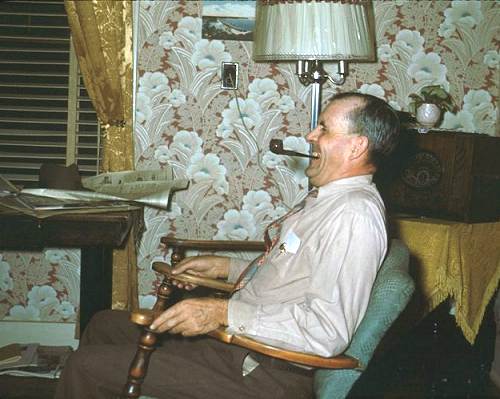
18 Madison Bear
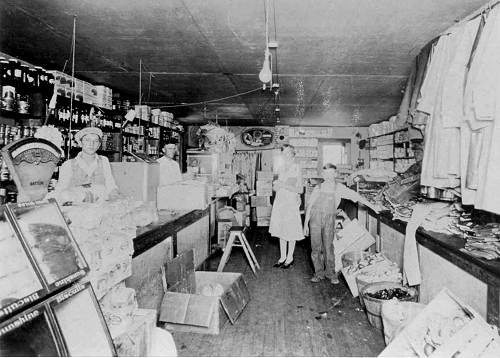
19 Bear Bagnell Store, Frank Martin, Madison Bear and David Bear
He had another store in Tuscumbia which my grandmother managed while he drove to Bagnell everyday to run the one there. Frank Martin and Ernest Abbett (photo 20 and photo 21 of Frank and Ernest) worked for my grandfather and stayed there at night after he returned to Tuscumbia.
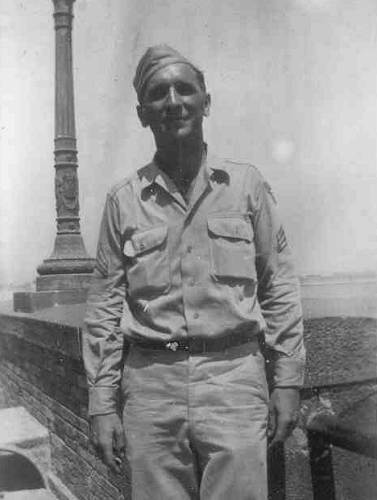
20 Frank Martin

21 Abbett Family: Sadie, Alma, Barcy, Ella, Cleo, Herman, Charlie and Ernest
At that time Bagnell was a “wild west” type of place and no store was safe from robbery so most everyone maintained some type of vigilance to protect their property. That is why Frank and Ernest were in the store the night it burned. Frank was the son of Madison’s sister, Cristina, and Ernest was the brother in law of Madison, who had married Ernest’s sister, Sadie Abbett. Mr. and Mrs. Ernest Howard, who are also mentioned in the article, were good friends of Madison and were the parents of Dr. Paul Howard of Tuscumbia and grandparents of Connie Howard Wyrick (who, by the way, is one of Miller County’s really great school teachers).
Have Narrow Escape From Fire At Bagnell
Five Buildings Burn
Madison Bear Heavy Loser
Tuscumbia Autogram
January 11, 1932
Frank Martin and Ernest Abbet, Clerks in Bear Store, and Who Were Sleeping in the Building. Emerge from Room as Burning Roof Falls Onto Bed; Third Disastrous Fire at Bagnell in Past Year
Another devastating fire swept Bagnell early Tuesday morning which destroyed five buildings including the Madison Bear Store, the only remaining general store the town had. The fire was discovered at about 3: 40 a.m. in the rear of the R.C. Petermon grocery store, the next building to the south of the Bear store, and which had been previously occupied by O.W. Wright’s drug store.
Frank Martin and Ernest Abbet, who were sleeping in the Bear store as clerks, came very near losing their lives in the flames. They were sleeping in a small room in the rear of the store building. Frank was awakened by the excessive heat as flames had enveloped the room which was covered with sheet iron which was almost red hot. He jumped from the bed and awoke Ernest. The latter mistakenly grabbed Frank’s trousers and tried to put them on, and as Frank had put the key to the room in his pocket Frank searched the wrong trousers (Ernest’s) for the key. They were trapped in the room with no instrument to break down the door. About this time Basil Payne, who knew the young men were in the building, called them and when he was told to break down the door he did so by crashing into it. The two escaped without their shoes and some other clothing which the fire destroyed and the roof of the building fell onto their bed just as they escaped.
Five buildings were burned but the greatest loss was entailed by Mr. Bear. He had recently taken an invoice and he estimates his loss at between $4,000 and $5,000. Owing to the nature of the buildings and previous fire losses, insurance companies would not take the risks, and Mr. Bear carried no insurance. There was very little merchandise in the Peterson store. Two of the other three buildings were vacant. One had housed the Asel Meat Market and the other a barber shop during the hey day at Bagnell while the Dam was being built. The two story Kelsay pool hall was saved by strenuous work on the part of volunteer fire fighters.
The small frame building, just to the rear of the Bear store, was also burned. Mr. and Mrs. Ernest Howard were living in the building, but were away from home visiting Mrs. Howard’s parents, Mr. and Mrs. Flavy Buster of near Eugene. All their house hold goods, valued at $350.00 were destroyed without any insurance.
This is the third big fire which Bagnell has experienced in the past year, and very few business houses of the thriving boom town of two years age remain. On March 16 of last year, 19 business houses were destroyed by fire entailing the loss of $100,000 and costing the lives of two men. Then on April 30, six weeks later, fire obliterated another section of the town, leaving only a few buildings east or north of the Missouri Pacific tracks where the business section of the old original town was situated. Since those two fires, practically all the business of the town was in the new section built up between the Missouri Pacific station and Little Gravois creek.
Bagnell has no general store now, and citizens of the town are urging Mr. Bear to arrange to continue the business there on a new location. He also owns a store at Tuscumbia, and operated the two stores ever since work started on the Bagnell dam.
Another part of this story of miraculous escape is made even more amazing when you consider that Ernest Abbett tended toward being obese (I remember he was plump enough that he often played Santa Claus at Christmas time) while Frank was always slender in build. So Ernest had so much difficulty getting Frank’s pants on (remember the story says that each tried to put on the other’s pants) that by the time the two discovered the pants error and that the keys were actually in the pocket of the pants Ernest was squeezing into, the pants were so tight he couldn’t get his hand into the pocket to retrieve the keys. Thank goodness for Basil Payne who was big and strong enough to bust through the door!
Last week we had some visitors to the museum who were in Tuscumbia to attend the annual Tuscumbia High School Reunion. We were very happy to welcome three of the 1949 class, Harley Johnson, Bob Wyrick, and John Hunsaker (photo 22).
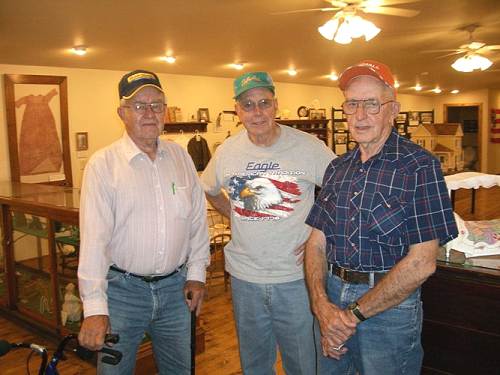
22 Harley Johnson, Bob Wyrick and John Hunsaker
In addition, we also had the honor of the visit of Gary Flaugher. Gary is the one who so generously donated the historic Lupardus cabin which is so prominently displayed on our museum grounds and in front of which this photo was taken last week (photo 23).

23 Gary Flaugher
Gary’s grandparents, Willard and Maggie Boyd, bought the Lupardus farm in the 1940’s and Gary was raised in this very cabin now sitting on our property. After he inherited the farm he later moved to the Kansas City area. So when the interest of members of the Lupardus family to purchase the cabin for the museum site was made known to Gary, he very generously donated the historic building free of any charge to the museum. You can read more about the log cabins on our museum property from the previous Progress Notes of March 31, 2008 and August 11, 2008.
You will have to scroll down the page on the Progress Notes for August 11, 2008 to reach the story about the cabins.
Don't forget to attend the U.S Memorial Highway Public Dedication Ceremony, October 23, 10:30 a.m. at the Osage Beach City Hall, Osage Beach Mo. where the new highway will be named in honor of Tuscumbia native Lee Mace. A couple of weeks ago I copied a display leaflet giving details about the event to which you can refer for more information.
Also, don't forget that our museum is hosting at its new facility in Tuscumbia its annual chili dinner Saturday, October 25 from 11 a.m. until 2 p.m. Special events will include an outdoor old fashioned apple butter making presented by Iberia resident Brian Duncan. Brian sends a special invitation to area children to come and help him stir the pot! Apple butter tasting especially will be enjoyed by all.
As usual this time of year every Saturday offers several events to which one can choose to attend. Next Saturday not only are we having our chili dinner but Old Bagnell is having its reunion, to which I referred above. But this year, naturally, as President, I will be at Tuscumbia helping host our chili dinner. I have noticed that many times people attend more than one event which I hope will happen this next Saturday. I think the apple butter demonstration we are having will be something special to see and enjoy!
That's all for this week.
|



